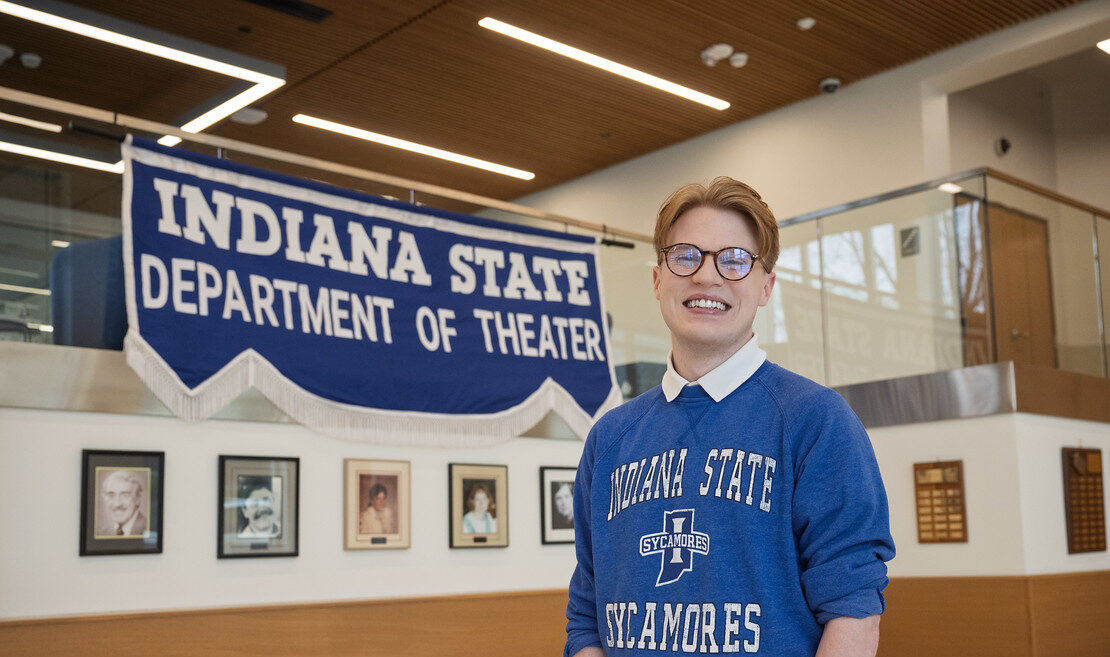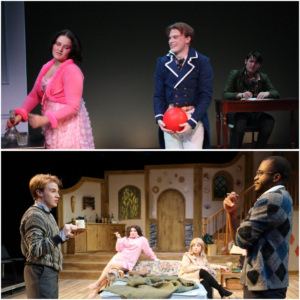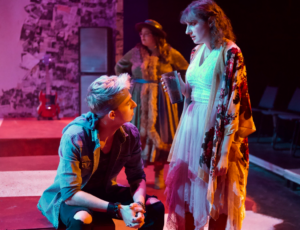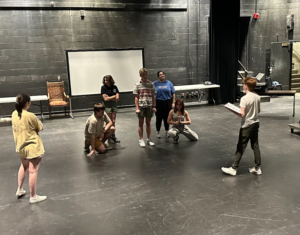
Craig Robinson
By Kasy Long
Apr 23, 2025
English Teaching Major
“To be or not to be, that is the question.” Unlike Hamlet in William Shakespeare’s epic tragedy, Indiana State University senior Craig Robinson, ’25, knows exactly who he wants to be: an English teacher dedicated to fostering curiosity, respect, and a love for reading.
“I want to be the kind of teacher my students can trust and feel respected by. They should feel comfortable asking questions and sharing their opinions,” says Robinson, an English Teaching major from Greencastle, Indiana. “Seeing students grow is one of the most rewarding experiences I could have.”
Robinson’s journey to Indiana State was driven by the University’s reputation as a supportive teaching school. From the moment he set foot on campus, he felt at home. He expresses, “I saw myself being a teacher, and I wanted to jump into the world of education. The vibes here just clicked. I knew Indiana State was going to be my home away from home.”

In his English Teaching program, Robinson has thrived in a curriculum that blends English literature and education courses. His favorite studies include contemporary poetry—particularly the works of Allen Ginsberg—and various writing techniques.
“My professors are some of the most professional people I’ve ever met. I’ve learned so much from them about what it’s like to be an English teacher,” Robinson says. The Sycamore also finds strong support among his peers. “My graduating cohort feels like a family. We understand each other. It’s a community.”
During his student-teaching practice in Greencastle, Robinson taught middle and high school students, gaining invaluable classroom experience. He learned what works and doesn’t work in a classroom. “This is helping me grow as a teacher, and it’s been really rewarding to work with students,” he says.
While teaching middle school students, he also directed the school’s spring play, The Magic Flute. The production is a one-act play adapted by Wolfgang Amadeus Mozart’s opera. Robinson said he enjoyed working with young students early in their development as actors. His passion for education was sparked by his youth experiences teaching acting at theater camps, so it was a natural step to direct school productions.
“Any excuse to talk about acting is always a good excuse for me. I’m there to help build that foundation for where they need to go as actors. Seeing them grow in the weeks we’ve been in rehearsals, and knowing we’re setting these kids up for roles in years to come, is the best feeling in the world,” Robinson reflects.
Robinson knows exactly what it’s like to perform for audiences. With a theater minor, the Sycamore has performed in several Indiana State and Crossroads Repertory Theater productions, including Pride and Prejudice, Accomplice, and The SpongeBob Musical. He describes the Department of Theater as a family.
“I was able to get involved from day one. Everything is hands-on. Our faculty care so much about the art form, and they go above and beyond to make each production a memorable experience for us,” he shares.

Craig Robinson in performances of “Pride and Prejudice” and “Accomplice” (photos/Alicia Jay).
One of Robinson’s most rewarding experiences was adapting and directing Indiana State’s Fall 2024 play, Hamlet. “The play is a timely classic that everyone knows. It was important to tell the story in a context that would be easy to digest for the audience so they could get more out of the play,” Robinson says.
To accomplish this, Robinson adapted the play into a 1980s rock ‘n roll music show. Throughout the show, rock ‘n roll music played in the background, emphasizing dramatic scenes and showcasing Hamlet’s rebellious nature.
“The play’s themes of grief and change resonated with me. The show begins with this power transition between Hamlet’s father and Claudius, Hamlet’s uncle,” he says. “There is so much change, not to mention the changes in Hamlet’s personal life with his father’s death. So, I thought the rock ‘n roll music would give a strong, emotional hook.”
“The 1980s was a huge transitional period with society, pop culture, and technology. Hamlet’s going through a transition, too,” he adds.
Robinson’s adaptation also highlighted Ophelia, Hamlet’s love interest. In Shakespeare’s drama, Ophelia is often underplayed despite her struggles with grief. Her father passed away, and her boyfriend is descending into madness. She’s a grieving young woman who ultimately drowns in a state of madness.

A pivotal scene between Hamlet and Ophelia in Indiana State University’s production of “Hamlet” (photo/Alicia Jay).
In most productions, Ophelia dies offstage. But not in Robinson’s adaptation. He chose to feature Ophelia and her grief prominently. In the iconic monologue, “To be or not to be, that is the question,” Robinson split the lines between Hamlet and Ophelia, symbolizing the importance of mental health, grief, and change in both characters.
“It’s important for Ophelia to say something and speak,” Robinson says. He also staged Ophelia’s death onstage. He adds, “I always thought it was a cheap way to just throw her offstage and she’s gone. Absolutely not! She’s not crazy. She’s grieving. So, I wanted audiences to see what’s actually happening to her and have empathy for her.”
As the director, Robinson had high hopes for the audience’s reaction. He reflects, “I wanted audiences to feel a sense of freedom. A freedom to express themselves and their feelings without fear of judgment. Even though Shakespeare wrote the play forever ago, it can still hold up today and be relevant to how we all feel at times.”

Craig Robinson (far right) directing the cast of “Hamlet” (photo/Alicia Jay).
As he looks forward to Spring Commencement, Robinson is filled with fond memories of his time at Indiana State. He wouldn’t have wanted his college experience to be any different, he says.
“Indiana State has so many opportunities where you can get involved and meet people from all areas on campus. You can try new things and explore who you are, and I really appreciate that,” he shares.
Robinson is eager to offer similar learning opportunities to his future students. Whether he’s performing onstage, directing actors, or teaching young students about literary texts, Robinson is ready to go ALL IN to shape the next generation!

